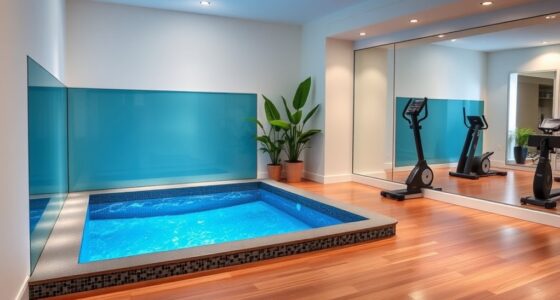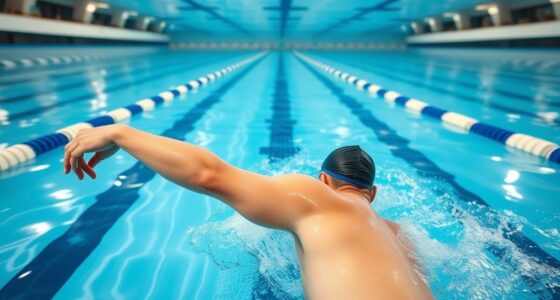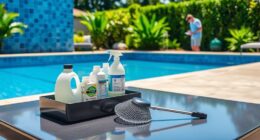To successfully shift from rehab to return-to-sport using an Endless Pool, start with a thorough injury assessment and set realistic goals. Incorporate water exercises that gradually increase resistance and complexity, utilizing water currents, balance drills, and sport-specific movements. Regularly monitor your progress, adjusting intensity as you regain strength and mobility. With a structured, progressive protocol, you’ll build confidence and safety in your recovery—keep exploring how to optimize your journey to full performance.
Key Takeaways
- Implement gradual resistance and intensity increases in water-based exercises to ensure safe progression from rehab to sport-specific activities.
- Incorporate sport-specific drills in the Endless Pool to simulate game movements like cutting, jumping, and pivoting.
- Monitor patient responses closely, adjusting exercise variables to prevent overload and promote steady recovery.
- Combine strength, endurance, and neuromuscular control exercises for comprehensive functional restoration.
- Use objective assessments and regular progress tracking to determine readiness for full return-to-sport.
Assessing Injury Severity and Setting Goals for Recovery

To effectively plan your rehabilitation, you first need to assess the severity of your injury. This involves understanding how much damage has occurred and how it impacts your movement. Pay attention to pain levels, swelling, and range of motion. If you experience intense pain or significant swelling, your injury may be more severe, requiring a cautious approach. Set clear, realistic goals based on your current condition, such as reducing pain, restoring mobility, or rebuilding strength. Be honest about what you can do without causing further harm. This assessment helps you and your healthcare provider develop a tailored recovery plan. Remember, accurately gauging injury severity guarantees you progress safely and effectively toward returning to your sport. Additionally, understanding the specific injury type can guide appropriate rehabilitation strategies.
Designing a Progressive Water-Based Rehab Program

To create an effective water-based rehab program, you need to focus on gradually increasing intensity to match your recovery progress. Incorporate targeted water exercises designed to improve strength and mobility without overloading your joints. Remember to monitor your responses and make adjustments to guarantee steady, safe advancement through each stage. Additionally, understanding the importance of progressive training can help optimize your rehabilitation outcomes effectively.
Gradual Intensity Progression
As you progress through water-based rehab, gradually increasing the intensity guarantees safe and effective recovery. You should systematically elevate workload to challenge your muscles without risking setbacks. To do this effectively, consider these key steps:
- Incrementally increase resistance or speed, monitoring how your body responds at each stage.
- Extend session durations gradually, ensuring endurance builds steadily.
- Introduce more complex movements as strength and stability improve.
- Embracing failure as a learning experience helps you adapt and refine your progression plan, ensuring resilience and sustained improvement.
This approach helps prevent overload and promotes consistent progress. By carefully adjusting these variables, you create a tailored progression that aligns with your healing timeline. Remember, patience and precision are crucial to avoid setbacks and maximize the benefits of your water-based rehab.
Targeted Water Exercises
Building on your gradual intensity progression, designing targeted water exercises involves selecting movements that specifically address your injury and recovery goals. You want exercises that activate the affected muscles, improve range of motion, and restore strength without overloading your body. Focus on controlled, purposeful movements like water walking, leg lifts, or resistance-based strokes, tailored to your injury site. Incorporate different water depths and speeds to gradually increase challenge. Use tools like paddles or resistance belts to add intensity as you progress. Remember, the goal is to target your specific weaknesses while minimizing strain. Incorporating specific tuning modifications can further enhance your vehicle performance and recovery outcomes. Keep exercises purposeful and aligned with your recovery milestones, ensuring each session builds toward your eventual return to sport. Precision in selecting these exercises accelerates healing and optimizes your rehab outcomes.
Monitoring and Adjustments
Effective monitoring and making timely adjustments are essential to guarantee your water-based rehab stays on track and progresses safely. You need to track your responses closely—how your body feels, movement quality, and strength gains. Consider these key steps:
- Regularly assess your pain levels, range of motion, and functional improvements.
- Adjust exercise intensity, duration, or complexity based on your feedback and progress.
- Collaborate with your rehab professional to interpret data and refine your protocol accordingly.
- Incorporate progressive water-based exercises to ensure a safe and effective rehabilitation journey.
Utilizing Variable Water Currents for Gentle Mobilization

Utilizing variable water currents offers a gentle yet effective way to promote mobilization during rehab. By adjusting the water flow, you can control resistance levels, making movements safer and more comfortable. This approach allows you to gradually increase activity without overstressing injured tissues. For example, starting with low-intensity currents helps loosen stiff joints and muscles while minimizing discomfort. As your strength and range of motion improve, you can slowly increase the resistance to challenge your mobility further. The adjustable nature of water currents also enables targeted therapy, focusing on specific areas needing attention. This personalized, low-impact method supports safe, progressive mobilization, helping you regain functional movement efficiently. Using variable water currents ensures your rehab stays adaptable and responsive to your evolving recovery needs. Incorporating progressive resistance techniques can further optimize your rehabilitation process.
Incorporating Balance and Stability Exercises in the Pool

Incorporating balance and stability exercises in the pool helps strengthen your core and improve control. As you progress, adding dynamic movements challenges your muscles further, boosting overall stability. These exercises set a solid foundation for safe and effective return-to-sport activities. Incorporating performance metrics can help monitor your progress and tailor your training plan for optimal recovery.
Enhancing Core Engagement
Adding balance and stability exercises in the pool is an excellent way to enhance core engagement during rehab. The buoyancy reduces joint stress while allowing you to focus on activating your deep core muscles. To maximize results, consider these strategies: 1. Incorporate unilateral exercises, like standing on one leg, to challenge stability. 2. Use unstable surfaces, such as foam pads or balance disks, to demand more core control. 3. Perform slow, controlled movements that emphasize proper alignment and muscle activation. Incorporating preppy dog names can add a fun and motivational element to your exercise routines.
Progressing Dynamic Movements
To effectively progress dynamic movements in the pool, you should gradually increase the difficulty of balance and stability exercises while maintaining proper control. Start with simple single-leg stands or gentle reaches, then advance to more challenging tasks like maintaining balance on unstable surfaces or performing movements while submerged. The key is to challenge yourself without losing form or control. As you improve, incorporate multi-directional movements and dynamic progressions to mimic sport-specific actions. Remember, consistency is essential for success.
| Progression Level | Exercise Example |
|---|---|
| Basic | Single-leg balance with arm reach |
| Intermediate | Dynamic balance on unstable surface |
| Advanced | Multi-directional movements in the pool |
| Sport-Specific | Cutting or pivoting drills in water |
Transitioning From Low-Impact to Dynamic Movements
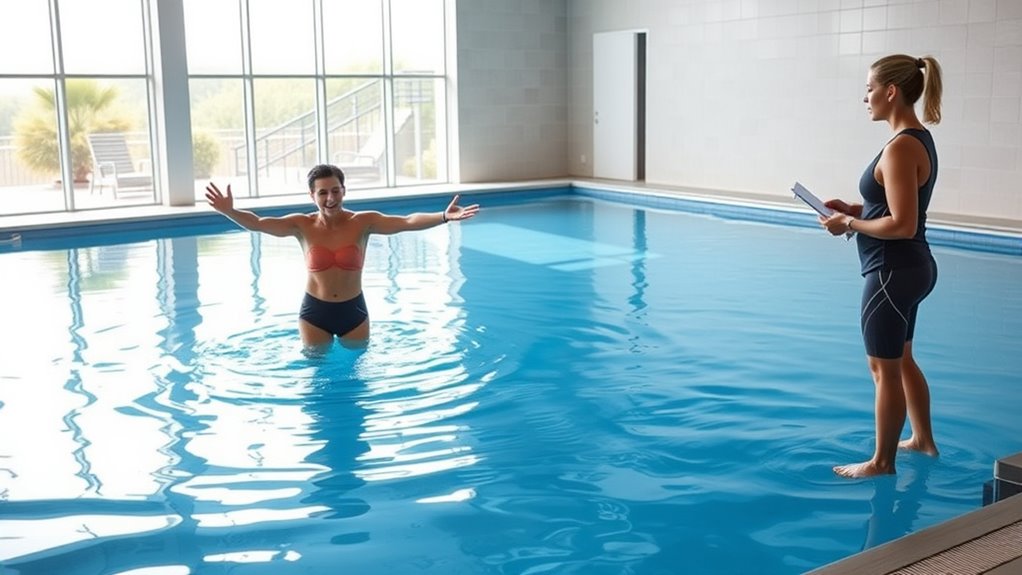
As you progress in your rehabilitation, shifting from low-impact to dynamic movements marks a crucial step toward regaining full athletic function. This transition challenges your body to handle more complex, sport-specific actions. To guarantee a smooth switch, focus on these key steps:
- Progress gradually by increasing movement complexity and intensity, ensuring proper form.
- Incorporate multi-directional drills that mimic sport-specific demands and improve stability.
- Monitor your response closely, adjusting intensity based on pain levels and fatigue to prevent setbacks.
- Pay attention to Cultural and Regional Breakfasts that can support your nutritional needs during recovery.
Implementing Sport-Specific Drills for Functional Restoration

To restore full function, you need to incorporate sport-specific drills that mimic real movements. Focus on simulating sport actions, integrating dynamic exercises, and adjusting the difficulty to match your progress. This targeted approach helps guarantee you’re prepared to return safely and confidently. Incorporating mindful decluttering strategies into your training environment can also enhance focus and reduce unnecessary distractions during recovery.
Simulate Sport Movements
Implementing sport-specific drills is essential for restoring functional movement patterns that closely mimic actual game scenarios. To effectively simulate sport movements, focus on progressive intensity and realistic scenarios. First, analyze the key movement patterns involved in your sport, such as cutting, jumping, or pivoting. Second, design drills that replicate these actions with proper technique, gradually increasing speed and complexity. Third, incorporate environmental elements like resistance or uneven surfaces to challenge stability and coordination. This targeted approach ensures your body relearns sport-specific skills in a controlled setting, reducing injury risk. By precisely simulating game movements, you foster neuromuscular control and muscle memory, paving the way for a confident, safe return to competition.
Integrate Dynamic Drills
Integrating dynamic drills into your rehabilitation program is essential for enhancing sport-specific functionality. These drills help mimic real-game movements, challenging your body to adapt to unpredictable scenarios. Picture yourself performing quick cuts, pivots, and reactive sprints that replicate in-game demands. To visualize, consider this table:
| Static Movements | Dynamic Movements |
|---|---|
| Standing balance | Cutting drills with quick direction changes |
| Controlled jumps | Reactive sprinting and deceleration |
| Isolated strength | Plyometric exercises for power |
| Fixed positions | Multi-directional agility drills |
This contrast emphasizes how dynamic drills push your limits, preparing you for actual sport situations. Incorporate these exercises progressively, focusing on quality and control to restore full functional capacity and confidence in your movement patterns.
Tailor Progression Levels
Progressing through sport-specific drills requires carefully adjusting intensity and complexity to match your evolving capabilities. To effectively tailor progression levels, focus on three key steps:
- Assess your current ability by monitoring performance and fatigue during drills.
- Gradually increase workload by adding speed, resistance, or complexity while maintaining proper form.
- Introduce sport-specific scenarios that replicate real-game situations to challenge your skills and decision-making.
Monitoring Progress and Adjusting Protocols Accordingly

Monitoring your progress throughout the return-to-sport process is essential to guarantee your recovery stays on track and to identify any setbacks early. Regularly assess how your body responds to increased activity, paying attention to pain, swelling, or fatigue. Keep detailed records of your workouts, noting improvements and issues. Use objective measures, like strength tests or range-of-motion evaluations, alongside subjective feedback. If you notice signs of overexertion or stagnation, don’t hesitate to adjust your protocols—reducing intensity, modifying exercises, or adding rest days. Communicate openly with your healthcare team to ensure your progress aligns with your goals. Consistent monitoring helps you make informed decisions, optimizing recovery and reducing the risk of setbacks, ultimately supporting a safe and successful return to your sport.
Integrating Strength and Endurance Training in a Controlled Environment
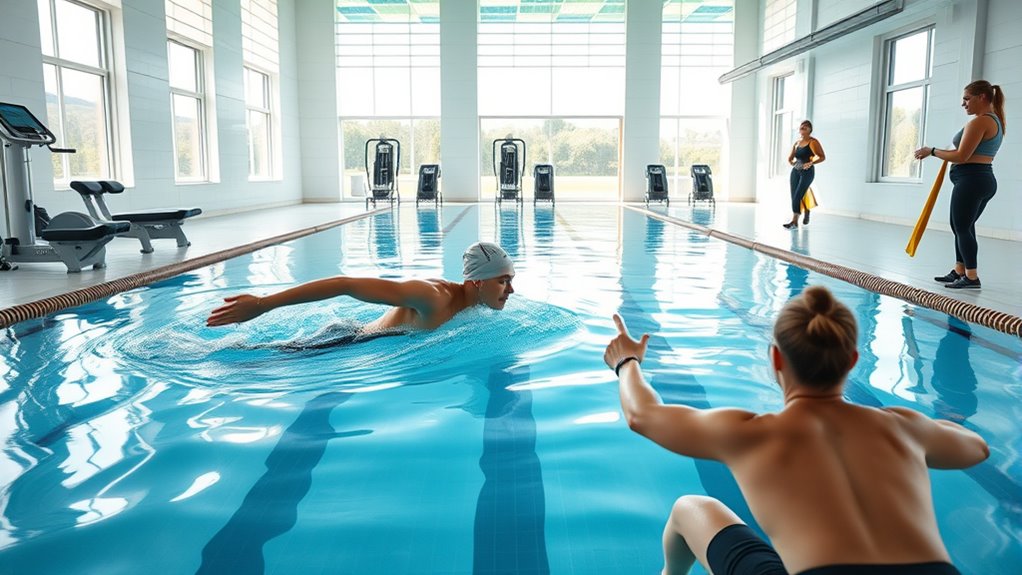
To safely rebuild your strength and endurance after an injury, it’s essential to train within a controlled environment that minimizes risks. The Endless Pool provides an ideal setting for this, allowing precise adjustments to intensity and resistance. To maximize benefits, focus on:
- Gradually increasing resistance and intensity, ensuring your body adapts safely without overexertion.
- Combining strength exercises, like resistance walking or water-based weight training, with endurance activities such as sustained swimming or aqua jogging.
- Monitoring your response closely, adjusting volume and intensity based on fatigue levels and recovery progress.
This structured approach helps you develop both strength and endurance simultaneously, reducing the risk of setbacks. By controlling variables, you optimize your recovery and set a solid foundation for the next phase of your return-to-sport journey.
Preparing for Full-Speed Return-to-Play Activities
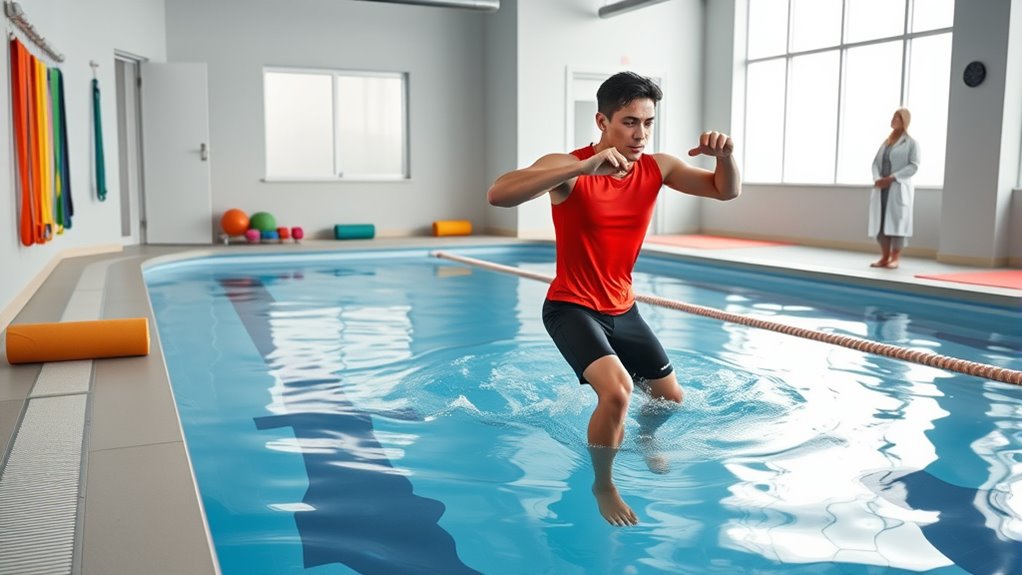
Preparing for full-speed return-to-play activities requires careful planning to guarantee your body is ready for the demands ahead. You need to gradually reintroduce high-intensity movements, ensuring your muscles, joints, and cardiovascular system can handle the stress. Start by performing sport-specific drills at moderate intensity, focusing on proper technique and control. Monitor your body’s responses closely—any pain, swelling, or fatigue signals that you may need to slow down. Incorporate plyometric and agility exercises to rebuild explosive power and coordination. Use the pool’s controlled environment to simulate real-game scenarios safely. Rest and recovery remain crucial; they help your tissues adapt and prevent setbacks. By systematically progressing in intensity and volume, you set a solid foundation for a confident, full-speed return to your sport.
Ensuring Long-Term Maintenance and Injury Prevention

Maintaining your progress and preventing future injuries require consistent effort beyond the initial recovery phase. To guarantee long-term success, focus on these key strategies:
Consistency and awareness are essential for long-term injury prevention and optimal performance.
- Incorporate regular strength and flexibility exercises tailored to your sport and daily activities.
- Monitor your body’s signals, and address pain or discomfort early before they develop into serious issues.
- Follow a structured, progressive training plan that gradually increases intensity, allowing your body to adapt safely.
Sticking to these practices helps reinforce your gains, reduces the risk of setbacks, and promotes sustainable performance. Remember, injury prevention is an ongoing process, not a one-time fix. Consistency and awareness are your best tools for staying healthy and at your peak.
Frequently Asked Questions
How Do I Determine the Appropriate Water Temperature for Rehab Sessions?
You determine the right water temperature by considering your rehab goals and patient comfort. For most rehab sessions, keep the water between 88-92°F to promote muscle relaxation and reduce pain. If you’re focusing on gentle stretching or early recovery, aim for the lower end. For more intensive exercises, slightly warmer water around 92°F can help. Always monitor patient feedback and adjust the temperature as needed for safety and effectiveness.
What Are the Signs of Overexertion During Water-Based Rehab?
Overexertion during water rehab is like pushing a car uphill—you’ll feel your limits. Watch for excessive shortness of breath, dizziness, or muscle fatigue beyond normal. If you start to feel nauseous, experience chest pain, or your heart races uncontrollably, stop immediately. These signs indicate you’re overdoing it. Trust your body’s signals, and communicate with your therapist to adjust intensity, ensuring safe progress without risking setbacks.
How Can I Adapt Protocols for Different Injury Types or Athlete Levels?
You should tailor protocols based on the injury severity and athlete’s experience. Adjust water resistance, duration, and intensity gradually, monitoring responses closely. For beginners or less severe injuries, start with low-impact, gentle movements, then progress as tolerated. For advanced athletes or more serious injuries, incorporate higher resistance and complex exercises. Always collaborate with healthcare professionals to make certain your adaptations promote safe, effective recovery while respecting individual limits.
Are There Contraindications for Using Variable Water Currents in Recovery?
Yes, there are contraindications for using variable water currents in recovery. You should avoid them if you have open wounds, skin infections, or cardiovascular issues, as the added resistance can strain your heart or cause discomfort. If you’re pregnant or have balance problems, consult your healthcare provider before starting. Always start with lower intensity and gradually increase to make sure your body adapts safely to the water currents.
How Do I Safely Progress From Pool Rehab to Outdoor or Land-Based Training?
Think of your recovery as climbing a gentle hill—you start slow and steady. To safely progress from pool rehab to land-based training, gradually increase the duration and intensity of your workouts. Incorporate weight-bearing exercises, monitor your pain and fatigue levels, and consult your therapist regularly. This step-by-step approach helps your body adapt smoothly, building strength and confidence without risking setbacks or injury.
Conclusion
As you progress through your rehab, think of the pool as your safe harbor, guiding you back to full strength. By following these protocols, you’ll build confidence and resilience, much like a sturdy boat weathering the storm. Stay patient, monitor your progress, and trust the process. With dedication and the right approach, you’ll return to sport stronger and more prepared—ready to sail smoothly into your next game.



